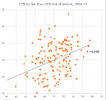Whileee
Registered User
- May 29, 2010
- 46,075
- 33,132
I looked at this a couple of years ago, and others have looked at it. CF% in the first 25-30 games is correlated with CF% and GF% for the remaining 55 games, or so.CF% and their so-called predictive value of future success
Let me understand the logic of this. Having a high historical CF% is predictive of future success because:
1. If you have a high CF% historically, it makes sense that you can continue to have a high CF% in the future
2. If you outshoot your opponents over a period of time, you will likely outscore your opponents over a period of time.
3. If you outscore your opponents over a period of time, you will likely have a higher victory % over time.
Is this the logic? If so, to prove out the predictive value of CF%, we should be going through each of these bullets rather than jump from having a high current CF% to future wins. The logic first needs to go from having a high current CF% to a high future CF%, right?
I may take a look at the CF% at the 20 game mark and see how well the logic holds but first, let's agree on the logic beforehand.
Here are the analyses of CF% up to December 8 (about 25-30 games) vs. CF% and GF% for the rest of the season for all teams, 2014-2019 seasons. Interestingly and perhaps not surprisingly, the best predictor of future success (from December 8 until the end of the season) is points%. Point% at December 8th is more highly correlated with points% for the rest of the season (data from 2016-19).
Data are from Natural Stat Trick. I think they are 5v5 SVA, but I could be mistaken about the selection.

